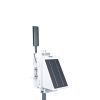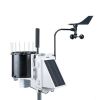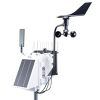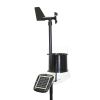Spectrum WatchDog 3220 Wireless Rain Stations
Features
- Integrated solar power system for reliable power
- Optional Wi-Fi or cellular modem for wireless communications
- Integrated data logger holds 18 months of data at a 15-minute recording interval
- Free ground shipping
- Expedited repair and warranty service
- Lifetime technical support
- More
Overview
The fully integrated WatchDog 3220 Wireless Rain Station measures rainfall, temperature, and humidity, recording and communicating the data to the cloud using its internal modem.
Benefits
- Integrated Solar Power system for reliable power.
- Integrated Modem/Radio for reliable communications: available with a choice of cellular modems or other radios.
- Integrated Data Logger protects your data. Holds over 18 months of data at a 15-minute recording interval. Data can be transferred to a USB flash drive.
- Easy to install - be running in minutes. Mounts to a 1.25 inch mast. U-bolts included.
- Bluetooth connectivity to your Apple or Android smartphone running the free WatchDog Mobile App speeds setup and displays current conditions.
- Sends data to the SpecConnect Cloud Solution - View current conditions or historical data using a broad selection of analytical reports from anywhere in the world.
- Receive alerts via automated phone call, text message, and/or email immediately when temperature crosses your selected threshold - no waiting for the next scheduled upload.
- Customizable with plug-in sensors to meet your needs
- Receive the latest changes with over-the-air updates (also available via a USB flash drive).
- Durable enclosure provides moisture, corrosion, and UV protection for increased reliability in harsh environments.
- Designed and manufactured in the USA to provide the quality data you can rely on.
- External Communication: Cellular, USB, Bluetooth, RS232
- External Sensor Ports: 1 x 2.5mm stereo jack (0 to 3.0VDC analog input)
- Data Capacity: 30,000 data intervals can be stored on the unit before the oldest record is overwritten by the newest data (312 days at 15 minute intervals).
- Dimensions (HxLxW): 12 x 19.5 x 11.25 in (30.5 x 49.5 x 28.6 cm). (Without 7.25 in (18.4 cm) antenna)
- Weight: 9.9 lbs. (4.5 kg)
- Power Source: 3.5W solar panel, Rechargeable 6V/4.5AH SLA battery, optional AC/DC power adapter.
- Battery Life: 14 days minimum with no solar power.
- LED: 3-color (Red, Amber, Green)
- Operating Temperature Range: -22° to 130°F (-30° to 55°C)
In The News
Stone Lab: Cyanobacteria Monitoring in Ohio Lakes
Microcystin, one of several toxins produced by the cyanobacteria that form harmful algal blooms (HABs), has become a popular topic of lake research as the human health impacts of HABs become better understood. Stone Lab is one of the leading groups in algal bloom research on Lake Erie and other lakes in Ohio. For more than 100 years, Stone Lab has conducted biology research and provided science education and outreach to the region. Over the years, thousands of individuals of varying ages have learned from the resources Stone Lab provides. Stone Lab’s Research Coordinator and Senior Researcher, Justin Chaffin, learned of Stone Lab while an undergraduate student at Bowling Green State University Fireland Campus.
Read MoreFrom Assessment to Angler: Continual Research Ensures Lake Erie Remains a Beacon of Freshwater Fishing
Lake Erie is well known for its abundant recreational fishing. Anglers come from across the country to try their luck at the “walleye capital of the world” and search for other freshwater species, such as bass, perch, and steelhead trout. As one of the world’s largest freshwater fisheries, much effort is made behind the scenes to maintain fishing opportunities for visitors to enjoy year after year, efforts that often go unnoticed by the public. One of the lake's most important economic and tourism centers is the city of Sandusky, home to the Sandusky Fisheries Research Station . As part of the Ohio Division of Wildlife, the unit serves as a base for assessing fish populations and managing harvest with partner agencies from around Lake Erie.
Read MoreHigh Definition Stream Surveys: Informed Management in Local Waterways
When it comes to environmental monitoring, new stream survey methodologies have revealed a great deal about water quality and streambed conditions over time. Such information can be particularly important in leading restoration initiatives and prioritizing management decisions. Historically, stream surveys have been conducted at a single point along the stream, with data then extrapolated for miles up and downstream. However, Brett Connell, Hydrologist and Director of Sales at Trutta Environmental Solutions, started developing a more intensive stream survey format in his master's program in 2010 at the University of Tennessee.
Read More



























